|
Just
for Babies
|
||
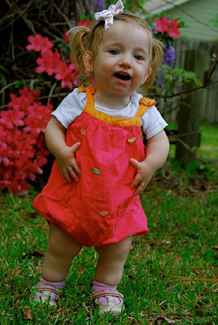 |
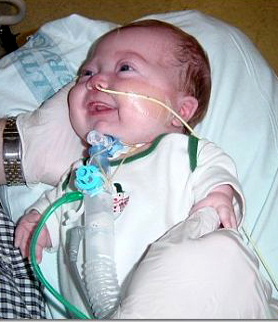 |
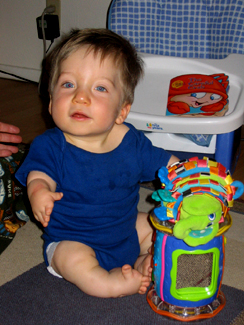 |
|
Just
for Babies
|
||
 |
 |
 |
You are now the parents of a beautiful DD baby -- Congratulations! You have a million questions and lots of concerns right now, but all will be well. Educating yourself about the ins and outs of DD, and LP (little people) life in general, are the keys to easing these worries.
While we do provide a few experience stories sent in by families (e.g., the DD Baby Ear Bubbles section below -- about the "cauliflower ear"; a "must read" for parents of new babies), we do not give any medical information on this website. There are other sites where this information is available. An excellent overview of the medical aspects of DD can be found in the eMedicine article "Diastrophic Dysplasia". Talk to other parents of DD children to find the orthopedic dwarfism specialists your child will need. But mostly just live your life and enjoy your darling baby!
Below are a few non-medical topics that are of interest to new parents. Also, feel free to use the "Ask a Mom" function of this website for any questions and other general information.
Baby
Milestones:
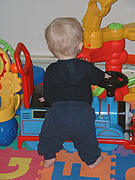
 The
physical milestones for DD babies are somewhat later than those of average-sized
babies, but there aren't any hard and fast rules. Some DD babies will
do things earlier or later than other DD babies, just as in the average-sized
population of babies.
The
physical milestones for DD babies are somewhat later than those of average-sized
babies, but there aren't any hard and fast rules. Some DD babies will
do things earlier or later than other DD babies, just as in the average-sized
population of babies.
In their medical journal article "Motor Milestones in Children with Diastrophic Dysplasia", authors M.M. Crockett, M.F. Carten, O. Hurko, and P.D. Sponseller (Journal of Pediatric Orthopedics; July-August 20(4): 437-441; 2000) state that children with DD roll over at 5.2 +/- 2.2 months, sit unsupported at 8.3 +/- 2.3 months, pull up to a stand at 13.5 +/- 5.8 months, and walk at 24.4 +/- 9.2 months. These statistics were based on 25 DD patients.
Several families have been kind enough to provide some additional information that parents of DD babies might find useful. Their statistics mesh well with the above reference.
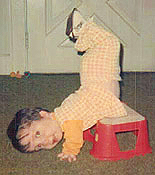
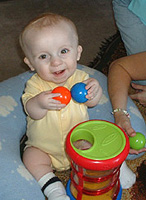 Getting
to sitting position alone is often accomplished at 12-24 months. While
some DD babies learn to push off with their arms to do this, others will use
a prop (toy, flipped-over plastic dish basin, pillow) to accomplish this task.
Tricks, like the one seen on the left, take more time! :)
Getting
to sitting position alone is often accomplished at 12-24 months. While
some DD babies learn to push off with their arms to do this, others will use
a prop (toy, flipped-over plastic dish basin, pillow) to accomplish this task.
Tricks, like the one seen on the left, take more time! :)
All of the milestones above are affected by the DD baby's short arms and legs, casting on the feet, foot and/or hip surgeries, trachs, back braces, etc. There is no one formula that fits all. Each DD baby will develop at his/her own rate with no physical therapy (PT) being necessary, except perhaps after orthopedic surgeries if your baby's orthopedist feels PT is warranted. Your baby will have fun, no matter what his/her milestone scenario is, so relax and have fun along with your baby!
We would like to publicly thank the following families for their participation in our survery of DD baby milestones: The families of Brad Clark, Ben DuGoff, Stefan Gagne, Chris and Josh Guffey, Benjamin and Cammie Head, Chris Kolavo, Larry McDonnell, Josh Phillips, Kyle Smith, Matt Stagi, Martha Holland Stanley, Dante Raso, Torie Webb.
For a fascinating and fun video view of active 5 year old DD, Kai Rivas, check out his ALS Ice Bucket Challenge here. For us parents, this video isn't just about the ALS challenge, but also about watching how a very young DD child brushes teeth, gets dressed, and is otherwise active, despite any limitations. Love those one-armed push ups!
Self-Feeding:
When we parents
first see our DD baby's hands, we wonder how they will be able to use them effectively. DD
hands work just fine "as is" and no splints or surgery are necessary
(and these techniques have been proven not to work anyway). Our babies
just do what comes naturally and learn to do everything with those cute little
hands and self-feeding is one of the tasks that they master. Pictured
below are some baby spoons that make it easier for your DD baby to learn to
feed him/herself, usually around 15-24 months old. The loop spoon and
the thin-handled spoons below work well for many DD babies and they are often
available in grocery stores, as well as places like Toys R Us.
Once your baby learns to feed his/herself, any lightweight eat utensil will
work well. Just toss it on the highchair and your baby will do what comes
naturally.
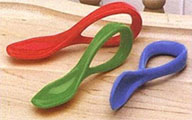 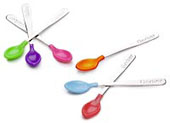
|
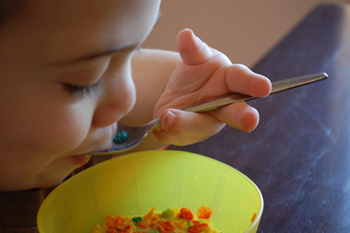 |
Baby Toys:
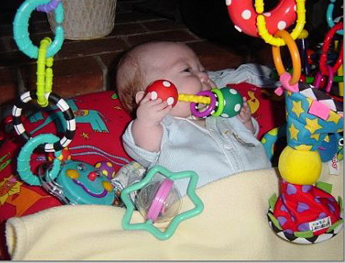
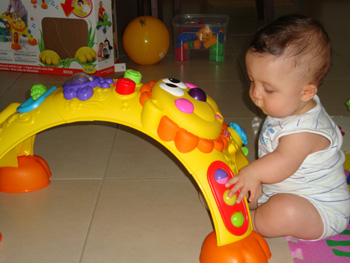
Choosing toys that can accommodate the small DD baby hands might seem like a
challenge at first, but as long as the parents keep in mind their child's hand
size, there are lots of choices -- almost too many, as anyone who has been in
a baby toy aisle can attest. Some have suggested that "thin"
toys are easier at first for small hands to grasp one-handed. Because
DD babies use their hands so effectively, toys that have to be manipulated work
just as well for them as they do average-sized babies. (See the 2004 Diastrophic Dysplasia Booklet
for more examples of what DD hands can do.)
DD Baby Ear Bubbles (Cauliflower Ear):
The following material tells of various families' experiences with their babies' cystic ear swelling, which can result in a cauliflower ear -- here, we call these swellings "ear bubbles". Please note that we are not doctors and do not impart medical advice, but instead just pass on experiences that might be helpful to others. While DD baby ear bubbles might look scary, they are actually relatively benign, even when absolutely nothing is done to them. Hopefully, these experience stories will help you (and possibly your doctor) decide what to do about your own baby's ear bubbles.
Almost all DD babies will develop a "bubble" on each ear, one ear at a time, between the ages of 3 to 6 weeks of age. A bubble can appear quickly, often in as little as 4 hours. Each bubble resolves about 3 weeks after its first appearance. Without treatment, the cartilage in the upper ears hardens into a unique shape termed "cauliflower ear" (Fig. 1b). The size of the bubble does not determine the outcome, and there are many variations of the "cauliflower ear" configuration, with some ears looking better than others.
While DD babies' doctors will often suggest that the bubbles be drained, this is unnecessary, according to most experiences reported by families. The latest way to deal with these ear bubbles is to use the tape-and-gauze compression method, which results in a much more normal ear configuration when the bubbles resolve (Fig. 2b). The basic idea of this method is to place gauze pads in front of and behind the ear, holding the pads in place with tape, followed by a headband type wrap of gauze. See below for one family's experience story with this method.
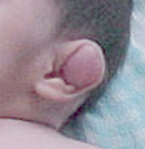 |
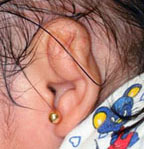 |
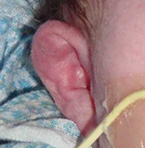 |
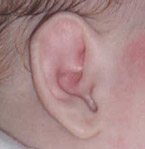 |
|
Typical Ear Bubble, Fig. 1a |
Resulting Cauliflower Ear, Fig. 1b |
Typical Ear Bubble, Fig. 2a |
Ear after Tape-and-Gauze Method, Fig. 2b |
Below is a description of the tape-and-gauze compression method, thoughtfully provided by Jadon Fry's parents. Jadon's bubbles each took 3 weeks to resolve. His results can be seen above in Fig. 2b.
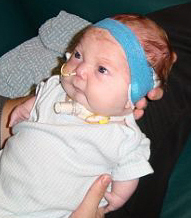 |
"We would put gauze behind his ear and covering his ear. The gauze behind the ear was an attempt to keep his ears in a more normal position and not pressed against his head. We would change the headband every few days when we would wash his hair. It took some time for us to learn how to make a "good" headband - one that was not too tight or too loose and one that was in a good position on his head. Coban, a brand of self-adhering gauze, seemed to work fairly well. We would also check his ears frequently to make sure they were still covered and to make sure they had not folded." |
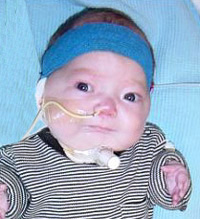 |
 Another
family's experience was similar, yet somewhat different. In their child's
case, the doctors drained the ears continuously and applied baby ear molds afterwards,
as well as the compression gauze. The final result is pictured at left.
Jenny Clark thoughtfully provided the following info:
Another
family's experience was similar, yet somewhat different. In their child's
case, the doctors drained the ears continuously and applied baby ear molds afterwards,
as well as the compression gauze. The final result is pictured at left.
Jenny Clark thoughtfully provided the following info:
"The ENTs lanced Brad's ears and applied a custom made form to each ear. The molds were then held in place by a tightly wrapped ace bandage. The ears were then lanced every other day and the forms were reapplied. This went on for 3 weeks and after the docs noticed no fluid build up for 2 molding changes, they left the molds and wrappings off and the swelling never came back."
For your enjoyment, some sweet parting photos...
|
Copyright © 1997-2016 by Vita Gagne All photographs on this web page are the copyrighted property of the webmaster or the individuals pictured, and have been posted with their permission. All rights reserved. To obtain legal copies of these photographs for any purpose whatsoever, contact Vita Gagne.
|
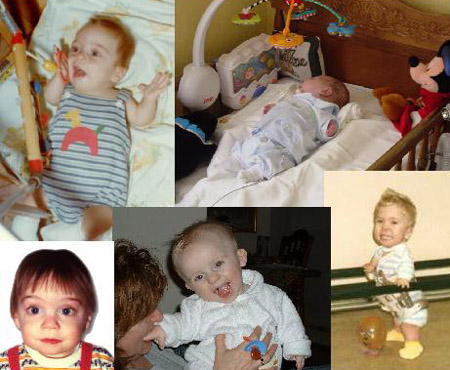 |